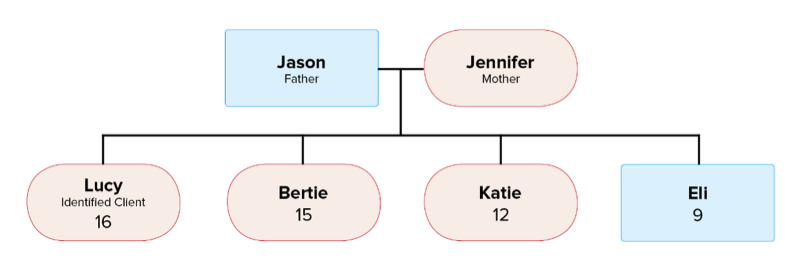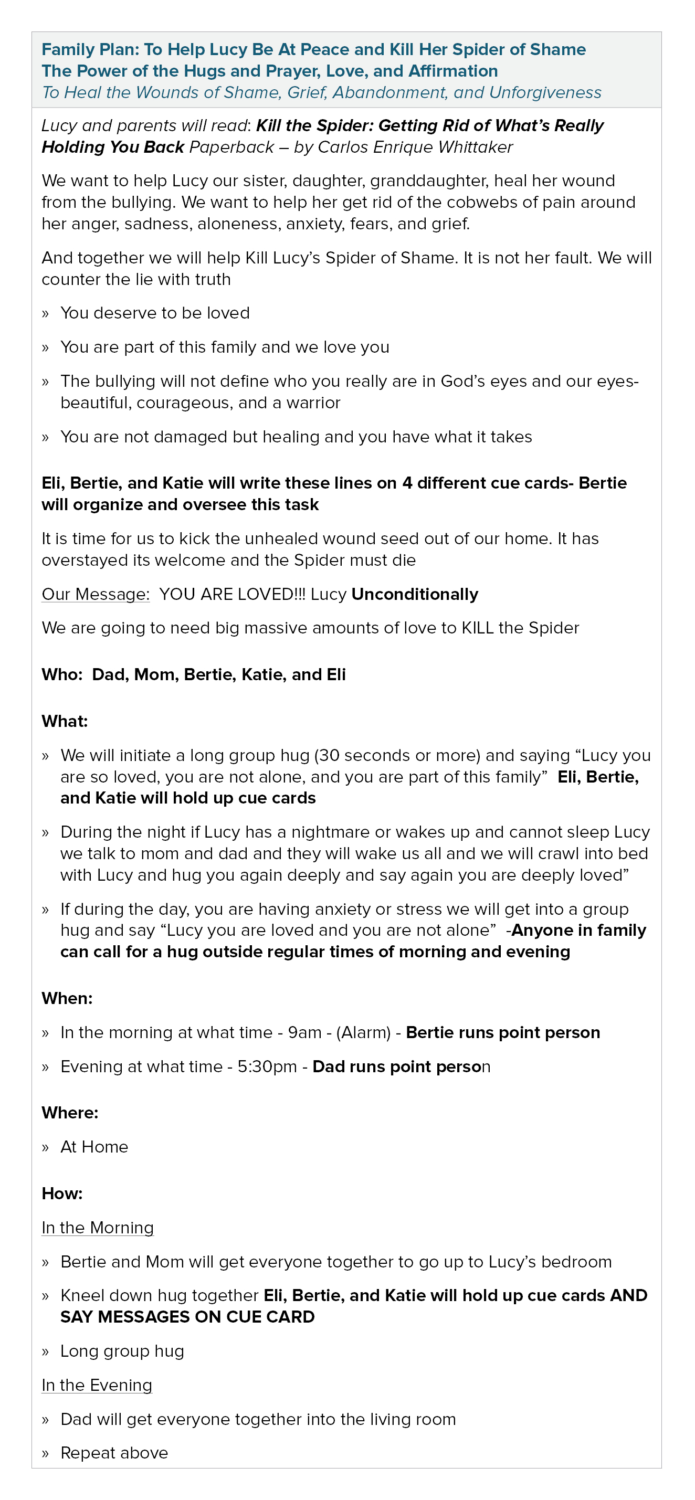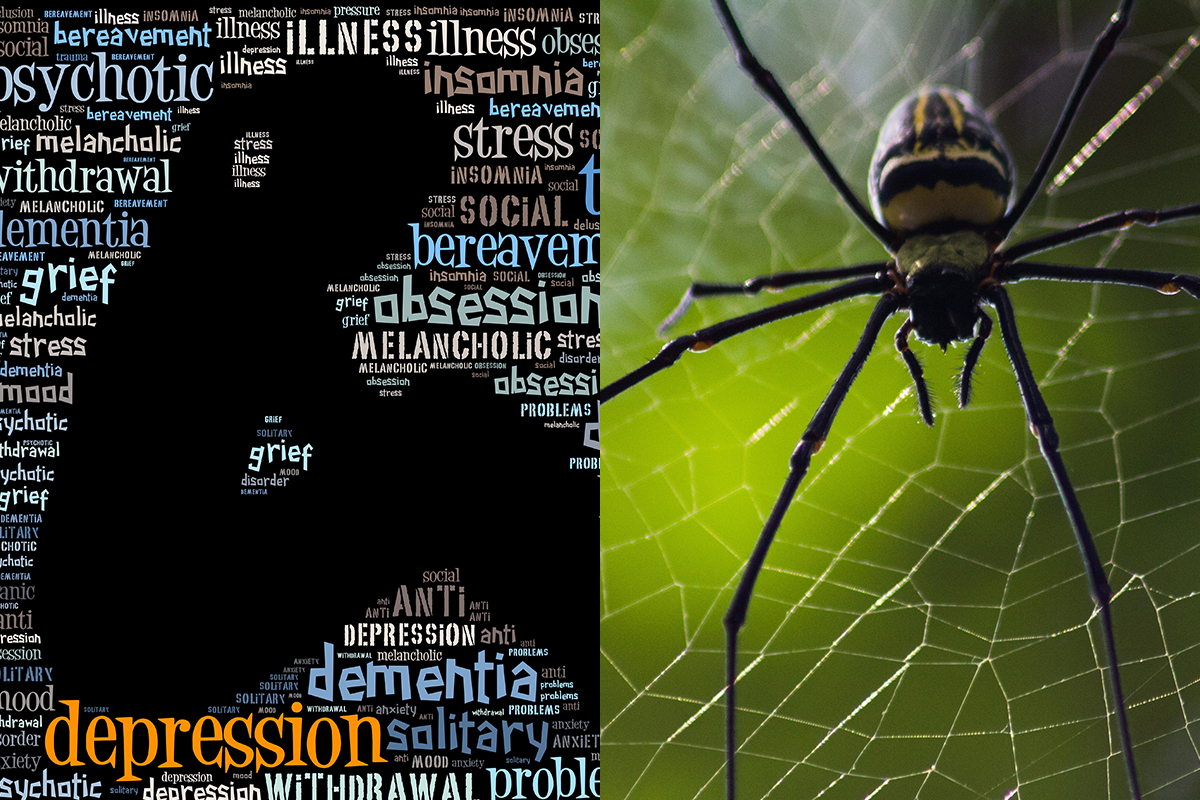Kill the spider describes what can happen when our client’s minds believe the lies perpetuated by a traumatic event. The result can be the stronghold of shame and require shame therapy. Cobwebs are the metaphor for the child’s trauma symptoms (i.e., depression, aggression, addiction, anger, self-harm) that medicate the stronghold of shame – the spider.
Trauma therapists who attend my workshops tell me it is easy to overlook the spider. They recommend therapeutic interventions that help the traumatized child and family cope with the cobwebs but leave the spider alive and well. When this happens, the root causes remain unaltered, and the child and family continue to relapse again and again.
To address this challenge, the Family Trauma Institute provides an evidence-based FST| Family Systems Trauma treatment model with step-by-step strategies to help the professional become a family trauma expert. One core strategy is the trauma playbook. In this article, I present the case study of 16-year-old Lucy and how the trauma playbook called Kill the Spider was used to heal her stronghold of shame through the vulnerability of her family and grandparents. For additional trauma playbooks, read Chapter Nine of Treating the Traumatized Child: A Step-by-Step Family Systems Approach.
Case Study Description*
*Note: I invite you to email me your stuck case for consideration to be highlighted in a monthly playbook. Email your case to info@familytrauma.com. If selected, I will contact you directly.
In this month’s case study, the therapist, Kelly Fallon, contacted me for a family trauma consult with Lucy and her family. A summary of the central problems include:

- Lucy is 16 years old and resides with her biological parents and younger siblings: Bertie, 15, Katie, 12 and Eli, 9.
- There is extreme conflict between Lucy and her parents as well as her three younger siblings.
- Lucy, the identified client, is in treatment due to self-harming behaviors (cutting), symptoms of depression, and anxiety.
- Lucy was bullied through 9th grade at school, but she kept it a secret. Since this traumatic event, her grades continue to plummet, her attendance is sporadic, and she suffers from depression and anxiety.
- The family is embroiled in a cycle of extreme verbal aggression.
- Both parents are overwhelmed and feel like they don’t know how to help. Dad can be emotionally reactive and feels the need to protect the family. Mom has feelings of guilt because of her mental health diagnosis and admits that following through is difficult.
- Counseling services initiated in January 2018. Lucy and her family are seen several times per week, every other week. Lucy is seen one-on-one at least two times during the week with family sessions on a third day.
Why Was the Family Trauma Specialist Stuck?
We discussed the challenges of the case that had kept Kelly stuck since January 2018. Kelly discussed there were three primary reasons for being stuck:
#1- A lack of engagement and participation of Lucy’s extended family.
#2- A lack of a clear trauma playbook with a clarity of roles for each family member.
#3- A lack of tools to convince the family that it was a family trauma issue and not a Lucy only problem that needed individual therapy.
Short video experts from my interview with Kelly, allow her to present each stuck area in her own words.
Lack of Participation by Extended Family
Whenever possible, at the Family Trauma Institute, we recommend the extended family members participate in the trauma treatment. They often bring a new and fresh perspective on how to support the immediate family or how to neutralize any negative influences. In Lucy’s case, the grandparent’s role in the Kill the Spider trauma playbook helped transform both Lucy and her family. To better understand the role of the extended family in FST| Family Systems Trauma model, please read our May trauma playbook: Get the Lights On: Basic Needs Before Psychological Needs.
Kelly’s Interview: Why the Extended Family is Important?
No Clear Plan for Shame Therapy or Trauma Playbook
In this interview excerpt, Kelly describes how not having a clear trauma playbook was keeping Lucy and her family stuck and why the Kill the Spider playbook in this article was the game changer.
Kelly’s Interview: Why Was the Kill the Spider Playbook a Game Changer?
Feedback Loops Provide Paradigm Shift for Family
The article, Rethink Child Trauma Using Feedback Loops, illustrates why and how the FST treatment technique of feedback loops was essential to move the family from what Prochaska, DiClemente, and Norcross (2007) term as a Precontemplative Stage of Readiness (i.e., “It is 100% a child only problem” or “Fix my child, I do not see that I am part of the problem or solution”) to the Contemplative Stage of Readiness (i.e., “Seeing what you call a feedback loop suddenly gives me new insight. It’s a family problem in which we all have to change.”).
Therefore, before introducing the Kill the Spider playbook, the trauma therapist must first use the feedback loop technique. In this video except, Kelly describes how the Feedback Loop technique enabled the family to see the situation differently. From this new perspective, Lucy and her family were ready for the Trauma Playbook.
Kelly’s Interview: Why Are Feedback Loops a Pre-requisite?
Undercurrents, Shame, and Trauma Playbooks
In Lucy’s case, the unhealed traumatic event of bullying was the catalyst to bring about both cognitive distortions or stronghold lies of shame and what the FST Model calls unhealthy undercurrents The undercurrents and strongholds come together to prevent Lucy’s traumatic PTSD symptoms and those of her family from naturally healing on their own over time. Over time, these strongholds and undercurrents become part of the family members new normal of communication patterns which we visually illustrate as feedback loops in the Rethink Child Trauma Using Feedback Loops article.
After the feedback loops are presented, the unhealthy undercurrents in the loops are summarized and presented as a handout before the presentation of the Kill the Spider trauma playbook. As illustrated in Table 1, the rationale for the undercurrents handout first is that connect the dots as to how and why the trauma playbook is used and applied. Simply stated, the Kill the Spider trauma playbook is like an antibiotic that is used to fill in Lucy’s missing healthy undercurrents as the anti-venom to Kill the Spider and permanently heal the roots causes of the trauma. Psychoeducation before the application is often needed before the introduction of an intervention. It is analogous to a doctor educating the patient about the surgery and answering any questions before it takes place.
Table 1: Unhealthy and Unhealthy Undercurrents

Table 2 was the second handout used to highlight those unhealthy undercurrents within the stronghold of shame. The cognitive distortions or lies Lucy believes about herself from the bullying over time lead to the unhealthy undercurrents of betrayal, unforgiveness, or lack of nurturance.
For example, once Lucy firmly believed that she was “damaged” she became angry and aggressive toward her family. In turn, the family started down the path of unforgiveness, anger, and bitterness. Lucy then started to feel the same way. The shame stronghold became the ticking time bomb that set off a chain reaction of unhealthy undercurrents.
Table 2: The Shame Stronghold

KILL THE SPIDER PLAYBOOK
After the undercurrent and shame handouts were explained, I, as the consultant, presented each family member with a working draft copy of the Kill the Spider playbook (Table 3). It is the first draft. The family was asked to customize and tweak it to fit their household. If there is 30 minutes or more left in your session, one can modify it during that session. It not, do the customization in the next session. It is important not to rush this process. The trauma playbook the centerpiece of family systems trauma.
Table 3: The Kill the Spider Trauma Playbook

How Did the Kill the Spider Playbook Realign Lucy’s Family?
The Kill the Spider Trauma Playbook helped realign and restructure Lucy’s family in the following manner:
- The intervention provided each family member with a clear roadmap of how to inject the healthy undercurrents back into the family through hugs and affirmative of the truth (i.e., “Lucy is not alone. That is a lie. She is part of this family.”).
- The book by Carlos Whittaker: Kill the Spider: Getting Rid of What’s Really Holding You Back provided homework to reinforce the intervention and about the spiritual side of the spider metaphor.
- Lucy’s siblings made poster boards to act as cue cards and counter shame messages. The Bible verse: the “Truth Shall Set You Free” becomes a reality and counters the stronghold shame lie.
- The Trauma Playbook involved everyone in the change process.
- The Trauma Playbook clarified family member roles with a clear answer to Who?, What?, When?, Where? and How? – For a chaotic and disorganized family, this kind of typed up clarity is a must have.
- The playbook answered the question of “now what?” What is the concrete plan in the here and now to help us heal Lucy’s trauma and ours as a family in the process?
- The playbook quickly enabled Kelly, the therapist, to get unstuck. Kelly had clear targeted undercurrents and a typed up plan to make these undercurrents a reality. For Kelly, she had stuck oil. She now knew exactly where to tap and was able to do root work instead of pulling weeds.
The Families Reaction to the Kill the Spider Playbook
As stated earlier, depending on how much time is left in the session, the trauma specialist may need to tweak the playbook and then practice its delivery through dress rehearsals. For detailed step-by-step procedures of how to implement dress rehearsals in trauma treatment read Chapter Eleven of Treating the Traumatized Child: A Step-by-Step Family Systems Approach.
However, depending on the level of experience of the therapist and the family, there are times when the playbook can be enacted immediately. In Lucy’s case, I asked everyone to hug Lucy. Listen to what happened next.
Kelly’s Interview: The Families Reaction
After the hugs, Lucy apologized to each family member, one at a time, for her aggression and disrespect. The apology was so heartfelt, that everyone in the family forgave Lucy with tears.
The Therapist’s Reaction to the Trauma Playbook
Kelly found the Kill the Spider Trauma Playbook transformative and one she could easily replicate with future families. Listen to why Kelly came to this conclusion:
Kelly’s Interview: How the Trauma Playbook Expands My Range
Postscript
After this session, Kelly reported the Kill the Spider Trauma Playbook set up a positive chain reaction throughout the family.
- Mom reported less depression and better marital relations,
- Lucy stopped self-harm cutting, and
- Lucy is more respectful.
Also, Lucy reported that the Kill the Spider metaphor helped her stop self-blame and shame; she now focuses on killing her spiders for good.
ADDITIONAL RECOMMENDED RESOURCES
Kill the Spider: Getting Rid of What’s Really Holding You Back by Carlos Whittaker
To learn additional FST Model Techniques, join me during my monthly webinars.
Scott P. Sells, Ph.D., MSW, LCSW, LMFT, is the author of three books, Treating the Tough Adolescent: A Family-Based, Step-by-Step Guide (1998), Parenting Your Out-of-Control Teenager: 7 Steps to Reestablish Authority and Reclaim Love (2001), and Treating the Traumatized Child: A Step-by-Step Family Systems Approach (2017). He can be contacted at spsells@familytrauma.com or connect with him on LinkedIn.

